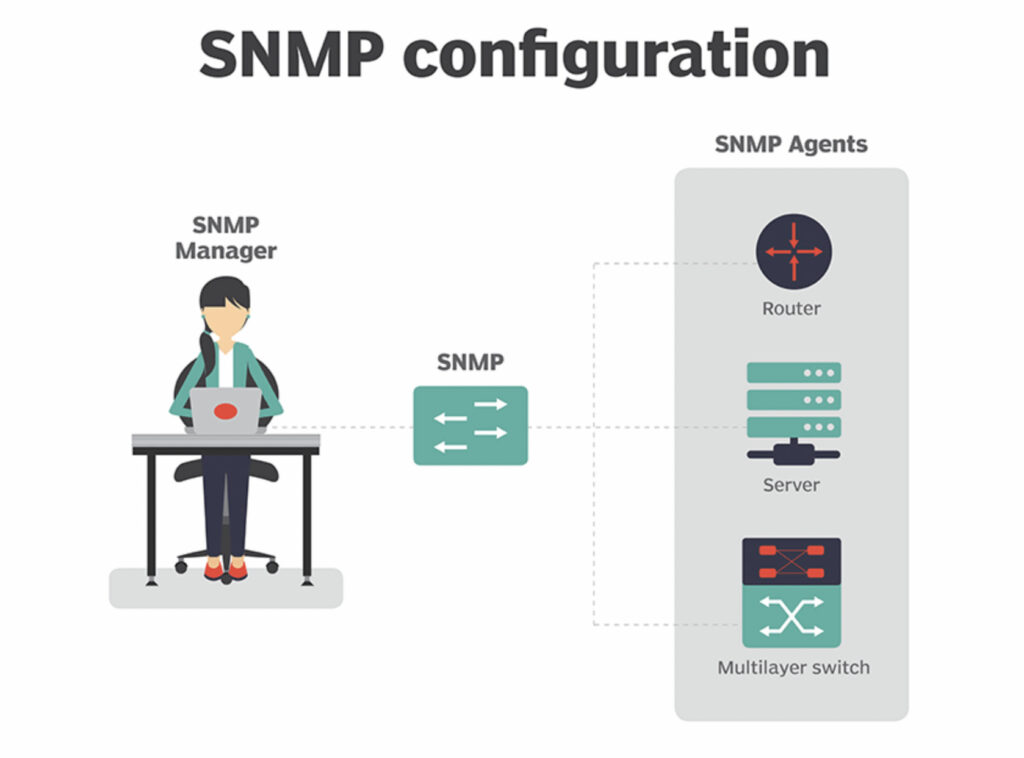Secure your business with CyberHoot Today!!!
Simple Network Management Protocol (SNMP) is an application-layer protocol for monitoring and managing network devices on a Local Area Network (LAN) or Wide Area Network (WAN). The purpose of SNMP is to provide network devices, such as routers, servers, and printers with a common language for sharing information within a Network Management System (NMS).
SNMP’s client-server architecture has the three following components:
- SNMP manager
- SNMP agent
- Management Information Base (MIB).
The SNMP manager acts as the client, the SNMP agent acts as the server and the MIB acts as the server’s database. When the SNMP manager asks the agent a question, the agent uses the MIB to supply the answer.
SNMP is so popular that most network devices come pre-bundled with SNMP agents. To make use of the protocol, however, network administrators must first change the default configuration settings of their network devices so SNMP agents can communicate with the network’s management system.
SNMP is part of the original Internet Protocol (IP) suite as defined by the Internet Engineering Task Force (IETF). Multiple versions of the SNMP protocol exist. The most recent version, SNMPv3, includes security mechanisms for authentication, encryption, and access control.
What does this mean for an SMB or MSP?
Additional Cybersecurity Recommendations
Additionally, these recommendations below will help you and your business stay secure with the various threats you may face on a day-to-day basis. All of the suggestions listed below can be gained by hiring CyberHoot’s vCISO Program development services.
- Govern employees with policies and procedures. You need a password policy, an acceptable use policy, an information handling policy, and a written information security program (WISP) at a minimum.
- Train employees on how to spot and avoid phishing attacks. Adopt a Learning Management system like CyberHoot to teach employees the skills they need to be more confident, productive, and secure.
- Test employees with Phishing attacks to practice. CyberHoot’s Phish testing allows businesses to test employees with believable phishing attacks and put those that fail into remedial phish training.
- Deploy critical cybersecurity technology including two-factor authentication on all critical accounts. Enable email SPAM filtering, validate backups, deploy DNS protection, antivirus, and anti-malware on all your endpoints.
- In the modern Work-from-Home era, make sure you’re managing personal devices connecting to your network by validating their security (patching, antivirus, DNS protections, etc) or prohibiting their use entirely.
- If you haven’t had a risk assessment by a 3rd party in the last 2 years, you should have one now. Establishing a risk management framework in your organization is critical to addressing your most egregious risks with your finite time and money.
- Buy Cyber-Insurance to protect you in a catastrophic failure situation. Cyber-Insurance is no different than Car, Fire, Flood, or Life insurance. It’s there when you need it most.
All of these recommendations are built into CyberHoot the product or CyberHoot’s vCISO Services. With CyberHoot you can govern, train, assess, and test your employees. Visit CyberHoot.com and sign up for our services today. At the very least continue to learn by enrolling in our monthly Cybersecurity newsletters to stay on top of current cybersecurity updates.
To learn more about Simple Network Management Protocol (SNMP), watch this short 3-minute video:
CyberHoot does have some other resources available for your use. Below are links to all of our resources, feel free to check them out whenever you like:
- Blog
- Cybrary (Cyber Library)
- Infographics
- Newsletters
- Press Releases
- Instructional Videos (HowTo) – very helpful for our SuperUsers!
Note: If you’d like to subscribe to our newsletter, visit any link above (besides infographics) and enter your email address on the right-hand side of the page, and click ‘Send Me Newsletters’.

